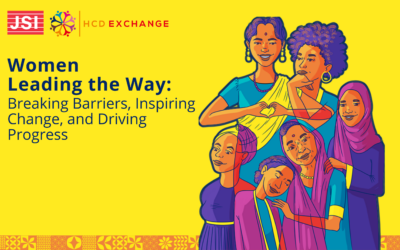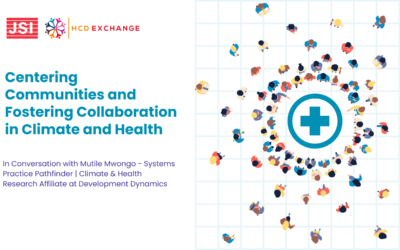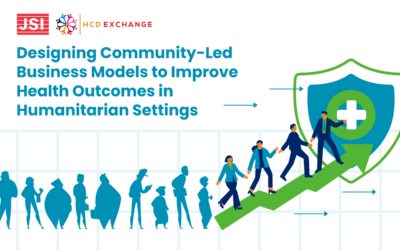Human-Centered Design (HCD) is becoming a more mainstream practice in health programming, particularly because of the approach to co-creating with program participants. This integration of HCD presents a complex mix of challenges and opportunities. Ambiguities arise in the practical application of the methodology, highlighting disparities between the theoretical possibilities outlined in the literature and the actual feasibility on the ground, especially in the Global South.
The HCDExchange and JSI’s USAID Advancing Nutrition (UAN) collaborated on a learning engagement to document learnings from integrating HCD methodology into UAN’s SBC approach. We held two Learning Circles where we aimed to create an open space for reflection and sharing on how to create and manage an integrated HCD project. These discussions aimed to be exploratory, and both retrospective and forward-looking, where participants drew on their experiences from the UAN activity and other similar projects to think ahead about how practitioners can improve these practices moving forward. Read the reflections from the first Learning Circle on pivoting and failing fast.
A Learning Circle is a format that brings together experts in a field to discuss a common topic of interest and learn through open, exploratory dialogue. Participants are invited to share from their own experiences and perspectives to learn and exchange with their peers. Key findings from the discussion are synthesized and documented to contribute to field-wide institutional and programmatic learning.
In this second learning circle, we brought together public health professionals, researchers, and HCD designers to shed light on the nuances and complexities surrounding the adoption and application of HCD by implementation teams who may have a theoretical or minimal practical understanding of the methodology. Insights were crafted from this discussion to paint a picture of the realities and best practices for bridging the gap between the theory and practice of HCD, especially in the context of a Social Behavior Change (SBC) program. Below are the major themes and key insights uncovered:
Value of HCD to SBC Programming
HCD helps to assess problems with a new lens and adapt existing solutions to fit the needs and wants of users. From the outset, participants in the learning circle were curious about how HCD could result in positive outcomes. They were looking for new ways to solve long-standing problems that other approaches had not solved effectively.
We have a lot of long-standing problems that are not getting solved. So to try a different approach and different framework for finding solutions to things that still seem to be a problem 50 years later, and having a new way to look at it was something that really interested me.
HCD goes deeper with stakeholder engagement. There was a sense of enthusiasm and interest surrounding the HCD approach due to its participatory nature: systematic engagement of stakeholders from inception to conclusion, fostering a collaborative environment conducive to innovation and co-creation.
One thing that I think is really special and useful about the HCD process is that the whole group of stakeholders is involved from start to finish, and I think that is different than other participatory methods.
HCD can be a mechanism for finding the balance between the lived experiences of program participants and the technical expertise of researchers and implementers. The methodology establishes a unique way of blending these elements because of the way that users are engaged in co-design consistently throughout the process. The depth of understanding and empathizing with program participants equips implementers with a holistic perspective while ensuring that solutions resonate with user needs while being technically sound.
It kind of balances the technical expertise — which I do still think is extremely important; we know that there are positive practices, that research matters – but balancing that with lived experience and with user expertise, because we also know best what works in our own lives.
Challenges
HCD ‘jargon’ can present a barrier to understanding and adopting HCD. Implementers found themselves grappling with design terminology, making the process feel inaccessible. Designers are therefore encouraged to communicate using accessible language, explaining and demystifying HCD concepts, and aligning on terminology that might hold different meanings across different sectors. This alignment serves as the cornerstone for effective collaboration and mitigating misunderstandings.
[One thing] that I struggled a bit with was a whole new set of terminology and that I had to get my head around. Like the ‘ideation’; [it’s] easy to understand once you know that it’s really a simple process of developing the different ideas to solve the challenge that you’re facing. So it was all this getting familiar with all this new language and looking at how this would all result in a product.
The HCD approach requires a shift in mindsets. Expert-driven mindsets may hinder the user-centric focus of the HCD process. Shifting the mindset to prioritize the needs and desires of program participants challenges implementers to step back and emphasize the value of lived experience, trusting that program participants know how to address their challenges.
I was interested in finding out what we would get from the research, and how [HCD] would add value to what we were already doing. I think what I call most difficult was coming from a kind of science-oriented way of thinking. Taking away your expert cap can be quite difficult when introducing HCD [into a project].
HCD challenges program implementers to come up against their assumptions and expectations for an effective solution. Preconceived notions and constraints set by implementers and other stakeholders can impede the creative process of ideation. Overcoming these limitations requires openness to exploring and considering diverse solutions.
In theory, in [HCD] you should be totally open to whatever the outcome is from your design research, and whatever solution is pointing you to. But what I found in practice, is that there are a lot of stakeholders with different interests who already have an idea of what they want the solution to be, and it’s very difficult, when you get into the practice side, to actually dislodge those preconceptions.
Implementing partners and donors can find it challenging to navigate the timelines and outcomes of the HCD process. The implementing team may have limited resources (i.e., time, bandwidth, and capacity) to fully engage in design activities and processes, particularly when HCD is brought into an ongoing project. Clear communication from the design team regarding the duration of the HCD process and the desired level of involvement from implementing partners and other stakeholders can help to manage expectations effectively. Building HCD into the work plan with the designers at the project design phase can also help mitigate challenges during implementation.
Not having a clear idea of what was going to come or how it was going to come about until you were doing it made developing a timeline difficult [and] sharing what a process would look like [also] a little bit difficult, especially when introducing new tools. It would be really advantageous to develop plans for research like this, where implementing partners do have specific resources carved out to participate in the work in a more active and engaged way.
Designers need to be considerate of the work that has already been done. Participants felt that their work and processes were undermined when the decision to integrate the design process was directed by the donor. These circumstances have the potential to foster heightened reservations about the process. It becomes the responsibility of designers to attentively listen to these concerns and directly address them with the implementers.
It’s very hard for [implementing partners] to forget about the product that they already built, that they put in their time and effort into.
Overcoming Challenges and Gaining Buy-in
The discussants shared how they managed to mitigate and overcome challenges, leading to buy-in to the HCD methodology across the project teams and the resulting adaptations.
There is a need to increase active involvement of implementing partners. Overall, successful implementation required frequent communication and transparency from the design team, and active involvement of implementers in key activities and decisions. This level of engagement helped to foster both buy-in and a sense of ownership and commitment to the HCD process while addressing the feeling of having their work challenged by new approaches.
Trust in the process, and try to engage [implementing partners] in many key activities, as much as possible is the way that we could get buy-in from multiple stakeholders. [The designers] coming to be with us, taking us through the ideation process as part of the central design team, it now became clear… that it was now a matter of adaptation to what we are already doing in our programming.
Implementers should have opportunities to try HCD practices for themselves. Implementing partners expressed a desire to understand the HCD approach comprehensively, emphasizing the need for active engagement and practical application to grasp the essence of HCD fully. Taking time to build capacity and understanding, and intentionally creating hands-on opportunities for implementing partners to practice HCD can amplify their receptiveness to the process.
Learning by doing is really key in the HCD process because it is something you have to kind of experience to really understand how it works.
Program implementers would have valued learning from peers who have utilized HCD in a similar project. Sharing documentation, case studies, and success stories from other development practitioners can help implementing partners and other stakeholders better understand the value, demystify the process, and adopt a more open and receptive mindset.
I think one thing in hindsight that could have helped was maybe early on kind of having an opportunity to hear from other development practitioners who have used HCD in the development world setting or public health programming and learning just a little bit about their experiences. It was great to get all the theoretical information at the start, and the training but it’s always good to kind of hear from someone who has walked the walk.
Bridging the Gap
The integration of HCD into public health and other development initiatives demands a delicate balance of comprehension, collaboration, and a shift in mindset. Fostering alignment across expectations and terminology, and actively involving stakeholders paves the way for a transformative journey, enabling the creation of user-centric solutions that address long-standing challenges faced by communities.
These are the key steps to consider when planning and implementing an HCD-integrated program:
| Project Planning | Project Implementation |
|
|
Resources
Key resources for building a work plan for an HCD-integrated program:
- Workflow for High-Quality Nutrition Social and Behavior Change
- Nutrition SBC Work Plan Checklist
- Quality & Standards Framework
Key resources for documentation:




